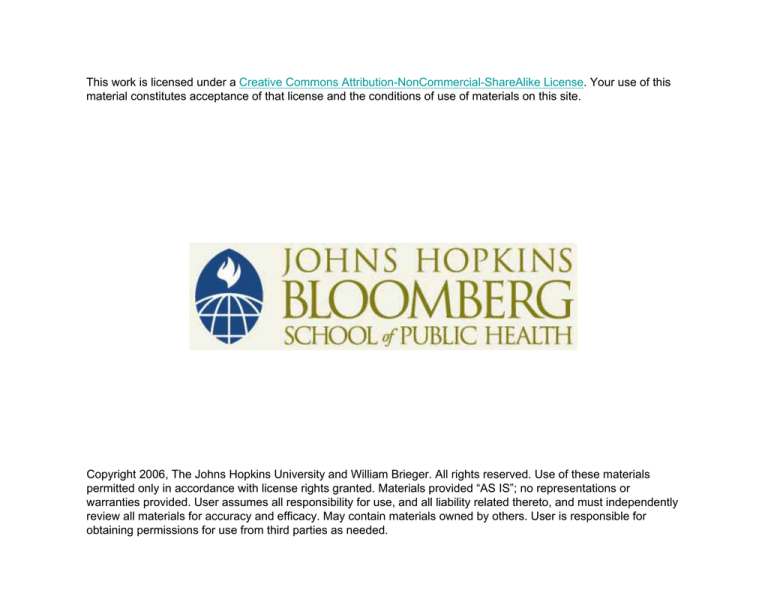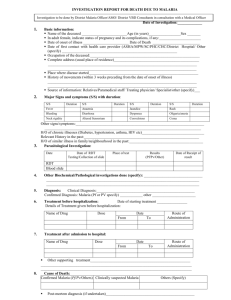
This work is licensed under a Creative Commons Attribution-NonCommercial-ShareAlike License. Your use of this
material constitutes acceptance of that license and the conditions of use of materials on this site.
Copyright 2006, The Johns Hopkins University and William Brieger. All rights reserved. Use of these materials
permitted only in accordance with license rights granted. Materials provided “AS IS”; no representations or
warranties provided. User assumes all responsibility for use, and all liability related thereto, and must independently
review all materials for accuracy and efficacy. May contain materials owned by others. User is responsible for
obtaining permissions for use from third parties as needed.
Theories and Models
to Understand Individual
Behavior
William R. Brieger, MPH, CHES, DrPH
Johns Hopkins University
1
Section A
Introduction: Types of Models
Local Explanatory Models
2
Types of Models and Theories
Ù Different types for different use, often
most valuable in combination
– Explanatory models
– Theory-based models
– Process models
– Planning models
3
Explanatory Models
Ù The insiders’ view of the world
– Can be individual or collective
– Consists of what people in a given
setting or culture believe about the
nature, cause, prevention, and
response to an event
Continued
4
Explanatory Models
Ù The explanatory model is not simply a
discrete set of ideas about a disease
Ù Cognizance of the broader beliefs
about how the body works and general
factors that influence a person’s fate in
life
5
Theoretical Constructs
Behavioral Determinants
Ù The simple approach is force field
theory, assumes a goal and factors
that are both driving and restraining
Ù Next step is to propose specific
concepts that may influence behavior
such as self-efficacy, locus of control,
outcome expectations, and intentions
Continued
6
Theoretical Constructs
Behavioral Determinants
Ù These concepts are used in various
combinations but ultimately take the
form of hypotheses that A
(Antecedent) is associated with B
(Behavior) or A influences B
7
Processes and Stages
Ù Behavior is not a monolithic construct
that can be turned off and on at will
Ù A “single” behavior is usually a
combination of steps
Ù The concept of readiness enters
– A person must be aware, have
considered, given the behavior a
trial, and then incorporated the
behavior into repertoire
Continued
8
Processes and Stages
Ù Process or “transtheoretical” models
tract this process and help determine
what a person may need to go to the
next stage
9
Planning Models
Ù Planning frameworks view the
foregoing models as “diagnosis”
preceding the selection of appropriate
strategies for behavioral intervention
Ù Such models have been developed to
prevent the common practice in health
education of using one strategy to
solve all problems
Continued 10
Planning Models
Ù These guide the planner to match
strategies with behavioral
determinants and the stages of change
in a culturally acceptable context
11
Gathering Information to
Develop the Models
Ù
Ù
Ù
Ù
Ù
Ù
Surveys, questionnaires
In-depth, key informant interviews
Focus group discussions
Pile sorts
Participant observation
Review of ‘texts’ including local songs
and poetry
12
Section B
Explanatory Models: Learning
from Local Perspectives
13
Explanatory Models
Define “Reality”
Ù Reality is socially and culturally
constructed from experiences
interpreted within a certain
environment
Ù Subjective experiences are validated
over time
Ù Objectivity does not exist, cannot step
outside
Continued 14
Inter-Subjectivity, not Objectivity
Ù Individuals in social relations share
their subjective interpretations and
together come up with an intersubjective definition of reality on which
most agree for a time
Continued 15
In the Eyes of the Beholder
This tree is
good for
shade
The fruit of
this tree is
very tasty
This tree
should be
worshipped
for the
goddess of
fertility
This tree
has good
bark for
medicine
16
Inter-Subjectivity, not Objectivity
Ù The blind men
and the
elephant?
© 2004 HCP Namibia,
Courtesy of Photoshare
17
An Explanatory Model
of Guinea Worm
Ù Systemic illness
– Sobia awoka,
egbesin sobia
Ù Localized, preswelling
– Akukudidi
Ù Local swelling
– Sobia, sobia eleta,
wiwu, koko ara
Continued 18
An Explanatory Model
of Guinea Worm
Ù Emergent
– Sobia
Ù Post-emergent
– Sobia Awoka
Ù See contrast—“Scientific Model” in
slide
19
Source: CDC
An orthodox medical explanation of the life cycle of guinea worm
20
21
Local Beliefs Revealed in
Surveys
Ù When asked whether anyone had
guineaworm in the past year
– 18% said moving pains—awoka
– 13% said swelling—wiwu
– 4% had egbesin—rashes
– 65% had emergent worms
Ù Overall 35% gave false positive
responses, as seen in the next slide
22
Epidemiology
of a Cultural Illness
Awoka
18%
Wiwu
13%
Egbesin
4%
Sobia / emergent
65%
Types of cases reported
23
Meanings and Interpretations
Ù Illness and technologies—Are there
connections ?
– What do people think about guinea
worm?
• Various presentations
• Part of body
• Can’t be prevented
Continued 24
Meanings and Interpretations
– What do people think about control
measures?
• Dressing angers the worm
• Filters strain what one can see,
dirt not g.w. which is already in
body
• Wells are useful and convenient
regardless of beliefs about g.w.
25
Interpreting Condoms
Analyze Three Issues
1. Condoms themselves
– Unnatural
– Might tear, get stuck inside
– Cause conflict in relationship
2. STDs
– AIDS is a foreigner’s disease
– Can’t get from younger people
Continued 26
Interpreting Condoms
Analyze Three Issues
3. Pregnancy
– Need to
demonstrate
fertility
– Can’t happen
first time
© Planned Parenthood
Federation of America, Inc.,
Courtesy of Photoshare
27
Section C
Types of Malaria and their
Meanings and Interpretations
28
Types of Malaria in
Nsukka, Nigeria
Ù Ordinary Malaria
– Fever, pain, weakness, dizziness,
tiredness, chills, and headache
– Caused by too much sun, too much
work, and mosquito bites
Continued 29
Types of Malaria in
Nsukka, Nigeria
Ù Yellow/colored malaria
– Yellow eyes, yellow urine,
headache, and fever
– Caused by too much sun/heat, too
much oil, dirty water, over-work,
and mosquito
Continued 30
Types of Malaria in
Nsukka, Nigeria
Ù Dry malaria
– Slim, shrink, dry-up, lose weight,
and become emaciated
– Caused by too much work,
exposure to sun, and poor feeding
31
More Types of Malaria
Ù Wet malaria
– Swelling, weight gain, dull feeling,
weakness, and cold
– Caused by cold/rain and poor
feeding
Ù Heavy/strong malaria
– Senseless talking, madness, very
high fever, serious headache, and
quick onset
Continued 32
More Types of Malaria
Ù Shaking malaria
– Abnormal talking and behavior,
headache, restlessness, and
tremors
– Caused by too much thinking,
charms, alcohol, and drugs (hemp)
33
Pile Sorts of Symptoms
Ù
Ù
Ù
Ù
Ù
Ù
Convulsions
Hot body
Dizziness
Headache
Vomiting
Cold/chills
Ù
Ù
Ù
Ù
Ù
Ù
Ù
Loss of appetite
Sleepiness
Lack of blood
Yellow urine
Yellow eyes
Weakness
Body aches
34
When Mapped Together
Clusters of common responses define
local illnesses
Ù Oyii
– Dizziness and lack of blood
Ù Iba
– Cold/chills and hot body
Continued 35
When Mapped Together
Ù Iba Ponju
– Yellow eyes, headache, yellow
urine
Ù Ako Iba
– Body aches, weakness
36
37
Interpretations
Ù Malaria control technologies
– Malaria medicines
• Herbal medicines make one
sweat out illness
• CQ does not cause sweat and
may even cause itching
Continued 38
Interpretations
Ù Malaria control technologies
+ Bed nets beautify home, may keep
warm in rainy season
+ Prevent insect nuisances, allow
better sleep
– But hot in dry season
– Since malaria caused by sun,
people ask how can nets prevent?
39
High school kids doing a
drama about a sick child
with malaria
Herbs and modern
medicine for malaria
40
Sleeping under bed
nets is a control
method for malaria
41
In “Praise” of Onchocerciasis:
Local Poetry Gives Explanatory Model
Ù Nárun àjàká òkò
– Onchocerciasis, with spots all over
the body
Ù “Ta ñ wolé”
– “Who is entering?”
Ù “Mátè mi mólè”
– “Please don’t step on me!”
Continued 42
In “Praise” of Onchocerciasis:
Local Poetry Gives Explanatory Model
Ù Asimo lówó oko riro
– That stops a child from hoeing
Ù Apani lókó
– That kills the penis
Ù Bani lárajé sákasàka
– That spoils the body with rashes
Ù Fowó tálè
– Groping about with hands on the
ground
43
Eating During Pregnancy
Ù Green vegetables cause stomachache
(with implications of miscarriage)
Ù “Bush meat” (e.g., monkey, snake)
could affect appearance of the child
Ù Casava fufu is heavy, causes
stomachache (or “hot stomach”) and
leads to miscarriage
Continued 44
Eating During Pregnancy
Ù Plantain could cause oka ori (sunken
fontanelle) later in the child
Ù Eating snails will cause child to
salivate too much
Ù Eating eggs may lead to difficult
delivery
45
Perception of Illness Influences
Treatment Behavior
Percent using ORT
Ù USE or Oral Rehydration Therapy
50
40
43.1
35.3
30
20
23.1
10
0
dysentry
watery
overall
Type of Diarrhoeal Illness
46
Interpretations and Meanings
Ù Jedi jedi literally means something
eating at rear end/lower back
Ù Feared because it might impair sexual
functioning
Continued 47
Interpretations and Meanings
Ù Dysentery (jedi jedi) is caused by too
much sugar and sweet things
Ù ORT with salt sugar solution is
dangerous—could make jedi jedi type
of illness worse
Ù Might even make diarrhea turn into jedi
jedi
48
Health Belief Synthesis
Ù Communication between scientific and
indigenous world views: creating new
inter-subjectivities
49
50




